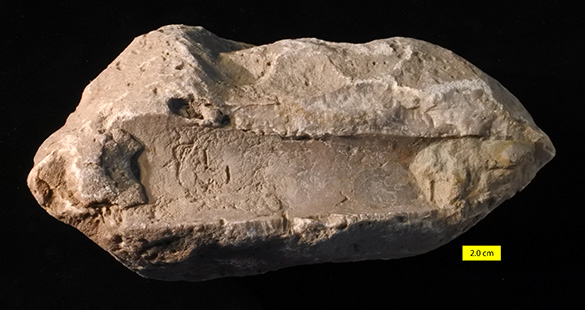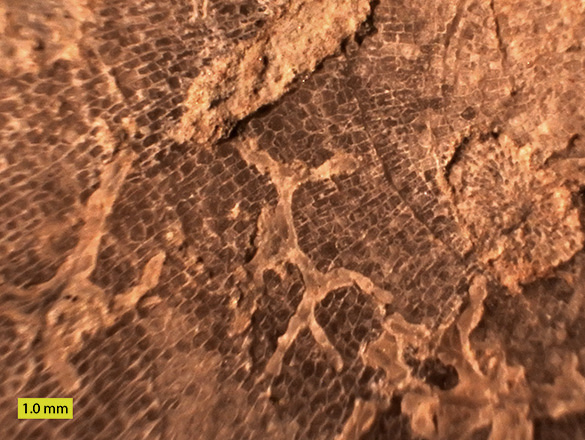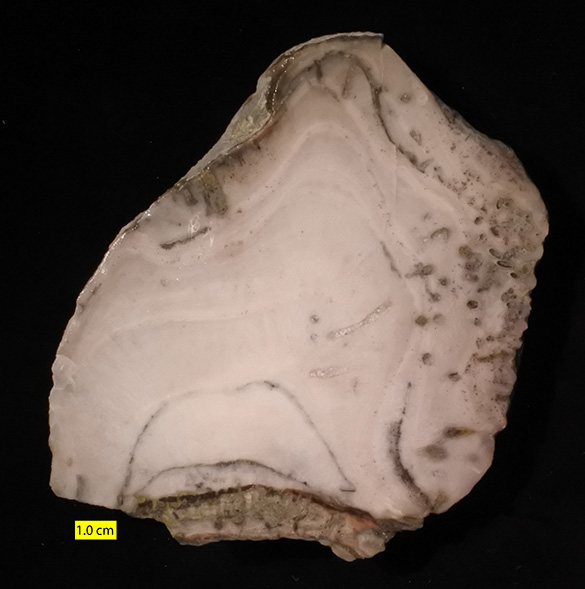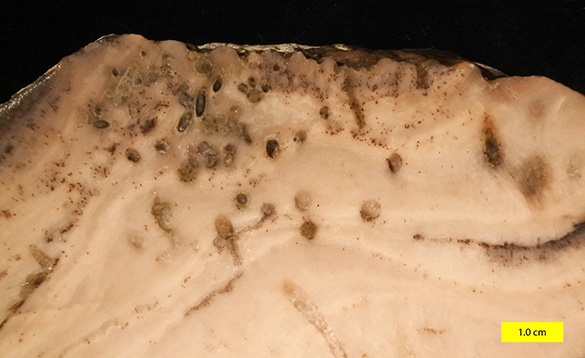 I have some affection for these odd fossils, the conulariids. When I was a student in the Invertebrate Paleontology course taught Dr. Richard Osgood, Jr., I did my research paper on them. I had recently found a specimen in the nearby Lodi City Park. It was so different from anything I had seen that I wanted to know much more. I championed the then controversial idea that they were extinct scyphozoans (a type of cnidarian including most of what we call today the jellyfish). That is now the most popular placement for these creatures today, although I arrived at the same place mostly by luck and naïveté. (I love the critical marks in that word! And yes, I always have to look them up.)
I have some affection for these odd fossils, the conulariids. When I was a student in the Invertebrate Paleontology course taught Dr. Richard Osgood, Jr., I did my research paper on them. I had recently found a specimen in the nearby Lodi City Park. It was so different from anything I had seen that I wanted to know much more. I championed the then controversial idea that they were extinct scyphozoans (a type of cnidarian including most of what we call today the jellyfish). That is now the most popular placement for these creatures today, although I arrived at the same place mostly by luck and naïveté. (I love the critical marks in that word! And yes, I always have to look them up.)
The specimen above is Paraconularia newberryi (Winchell) found somewhere in Indiana and added to the Wooster fossil collections before 1974. (The scale below it is in millimeters.) A close view (below) shows the characteristic ridges with a central seam on one of the sides.
 Conulariids range from the Ediacaran (about 550 million years ago) to the Late Triassic (about 200 million years ago). They survived three major extinctions (end-Ordovician, Late Devonian, end-Permian), which is remarkable considering the company they kept in their shallow marine environments suffered greatly. Why they went extinct in the Triassic is a mystery.
Conulariids range from the Ediacaran (about 550 million years ago) to the Late Triassic (about 200 million years ago). They survived three major extinctions (end-Ordovician, Late Devonian, end-Permian), which is remarkable considering the company they kept in their shallow marine environments suffered greatly. Why they went extinct in the Triassic is a mystery.
 The primary oddity about conulariids is their four-fold symmetry. They had four flat sides that came together something like an inverted and extended pyramid. The wide end was opened like an aperture, although sometimes closed by four flaps. Preservation of some soft tissues shows that tentacles extended from this opening. Their exoskeleton was made of a leathery periderm with phosphatic strengthening rods rather than the typical calcite or aragonite. (Some even preserve a kind of pearl in their interiors.) Conulariids may have spent at least part of their life cycle attached to a substrate as shown below, and maybe also later as free-swimming jellyfish-like forms.
The primary oddity about conulariids is their four-fold symmetry. They had four flat sides that came together something like an inverted and extended pyramid. The wide end was opened like an aperture, although sometimes closed by four flaps. Preservation of some soft tissues shows that tentacles extended from this opening. Their exoskeleton was made of a leathery periderm with phosphatic strengthening rods rather than the typical calcite or aragonite. (Some even preserve a kind of pearl in their interiors.) Conulariids may have spent at least part of their life cycle attached to a substrate as shown below, and maybe also later as free-swimming jellyfish-like forms.
It is the four-fold symmetry and preservation of tentacles that most paleontologists see as supporting the case for a scyphozoan placement of the conulariids. Debates continue, though, with some seeing them as belonging to a separate phylum unrelated to any cnidarians. This is what’s fun about extinct and unusual animals — so much room for speculative conversations!
[Thanks to Consuelo Sendino of The Natural History Museum (London) for correcting the age range of these fascinating organisms.]
References:
Hughes, N.C., Gunderson, G.D. and Weedon, M.J. 2000. Late Cambrian conulariids from Wisconsin and Minnesota. Journal of Paleontology 74: 828-838.
Van Iten, H. 1991. Evolutionary affinities of conulariids, p. 145-155; in Simonetta, A.M. and Conway Morris, S. (eds.). The Early Evolution of Metazoa and the Significance of Problematic Taxa. Cambridge University Press, Cambridge.
[Modified from an original post on July 31, 2011]












 The class cores an old growth living tree to help assemble a calendar dated tree ring chronology.
The class cores an old growth living tree to help assemble a calendar dated tree ring chronology. Dean extracts a core from a beam of the Tracy House under the watchful eye of Annette – the TA, as Conner looks on.
Dean extracts a core from a beam of the Tracy House under the watchful eye of Annette – the TA, as Conner looks on.

































